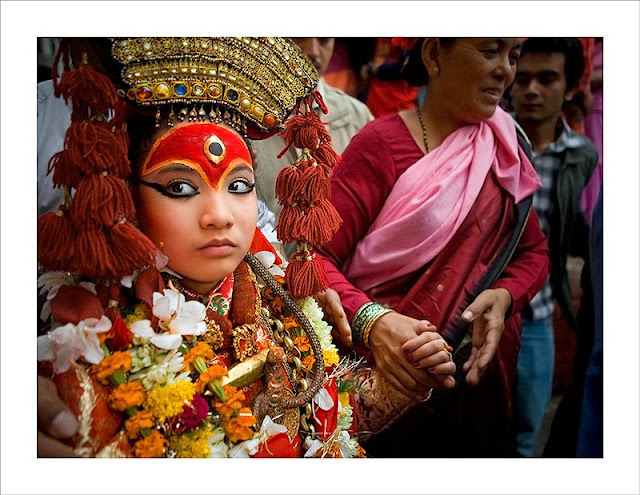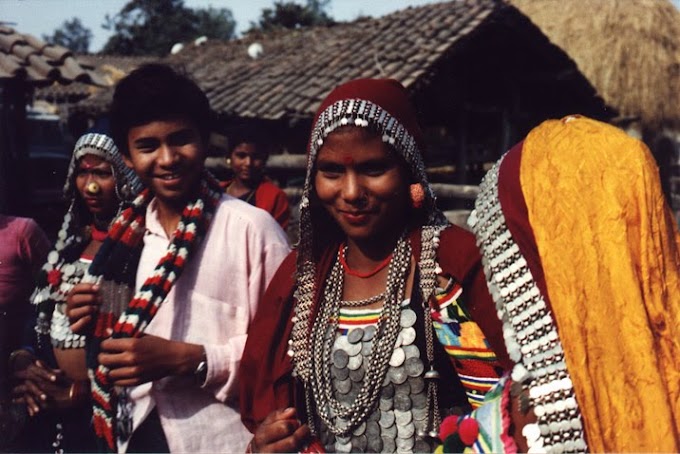
History
The Newars are regarded as the original inhabitants of the Kathmandu Valley, but their origins are shrouded in mystery. They speak a Tibeto-Burmese language, which indicates they originated in the east, but their physical features range from distinctively Mongoloid, again suggesting to east, to Indo-Aryan, which of course points to India. In balance, it seems most like that the Kathmandu valley has long been a cultural and racial melting pot, with people coming from both east and west. This fusion has resulted in the unique Newar culture that is responsible for the valley's superb art and architecture.
The Newar golden age peaked in the 17th century when the valley consisted of small city-states, and Nepal was a vitally important trading link between Tibet and the north Indian plains. the valley's visible history is inextricably entangled with the Malla kings. It was during their reign, particularly in the 1600's and 1700's, that many of the valley's finest temples and palaces were built. Competition between the cities was intense and an architectural innovation in one place, such as the erection of a column bearing a statue of the ruling king, would inevitably be copied in the other cities.
Sorting out who built what and when is considerably complicated by the fact that at any one time there was not just oneMalla king. Each of the three city-states in the valley – Kathmandu, Patan and Bhaktapur – had its own.
The unification of Nepal in 1768 by Gorkha's king Prithvi Narayan Shah signaled the end of the Kathmandu Valley's fragmentation. Nepali, an Indo-European language spoken by the Khas of western Nepal. replaced Nepalbhasa as the country's language of administration.
People
It is not surprising that the Newar people were influenced by Tibet and India. What is surprising is their creativity response to this stimulus, which actually led to a genuine exchange with their giant neighbors. Mediaeval Near society has left a religious architectural and artistic legacy that is unique, and spectacular by any standard.
Although most Newars have Mongoloid physical characteristics, some don't, so their origins are shrouded in mystery. It is now generally accepted that they are a mixture of many different peoples who were attracted to the valley, possibly origination with the Kiratis, or an even earlier group, Perhaps the Newars' most striking characteristic is their love of communal life. Newar houses were invariably clustered together, usually around sites of religious significance. Although their economy was centered around agriculture and trade, they created sophisticated urban communities which catered to a breadth of human needs in an integrated way that has rarely been matched.
'Today there are around 600,000 Newars largely centered in the Kathmandu Valley. Always traders and merchants, the Newars continue to fill this role throughout the kingdom. Their proximity to the center of power has also led to them having a disproportionate influence in the bureaucracies of Kathmandu. many now live in heartbreakingly ugly bungalows on the outskirts of the city proper, and many of their traditions are on the wane.
Music
The Newars are very much rich in traditional, classical and folk music as in dances. Various music and dance events take place in different parts of Newar societies on the occasion of different festivals. In fact, the Newars are so duly intermixed with music and dances that not a single festival, feast or ceremony, 'from womb to tomb', passes without a music or music and dances.
Various songs, musical instruments and dances are connected with various religious, social and cultural life of the Newars Different musical instruments are in practice in the festival, feasts, ceremonies and also in funeralprocession.
Musical instruments
It is believed that there are about 200 (two hundred) types of original musical instruments in Nepal, and 108(one hundred eight types) of musical instruments have been found till now. A great number of Newar musical instruments are included init. These instruments can be classified into four classes according to Sangeet Shastra.
1. Membranophones - Dhimay, Dhah, Paschima, NayaKhin etc.
2. Idiophones - Bhusyah, Chhusyah, TainNain etc.
3. Chordophones - Piwancha
4. Aerophones - Muhali, Nekoo, Bansuri etc.
Cuisines
Of all the Nepalese people, the Newars celebrate the greatest number of festivities and feasts. They are known for a immense variety of cuisines they prepare in many occasions. Newar food can be divided into two main types.
1.Daily foods- Jyona (Lunch), Beli (Dinner).
2.Bhoye- Banquet having a number of dishes with systematic arrangement in order.
The main dishes of the Newars are as follows-
Appetizers/Snacks
Chatanmari-It is something like what you call pizza. It is prepared from rice flour with minced meat or egging topping or also can be prepared plainly. It is mainly eaten in Digu Puja.
Wo-A flat cake of mashed lentils with or without egg/minced meat topping.
Samay Baji- A ritual set of five dishes representing Pancha Tatwa. It constitutes Baji, Samay (flattened rice), chhoyla (roasted meat), sanya (smoked fish), palu (sliced ginger) and aila (wine).
Chhoyla- Spicy meat, ether roasted or boiled known as haku chhoyla or mana chhoyla. It is generally served with flattened rice and homemade wine.
Sukula- Dried meat diced and spiced.
Tahkha- A jelly-like meat.
Main Dishes
Jyona/beli-Boiled rice. Usually these words stand for a set of rice, and curries.
Ken- Lentil soup served with rice.
Wauncha- Green vegetables, especially mustard/spinach in feasts.
Boobah- Bean curry.
La- Meat curries, various verities : Pukala (fried), Gorma (white jellied meat), Dayakala (curried meat), for instance.
Relishes
Sanan- Pickle, usually hot.
Sanya khuna/ Nya khuna- Jellied fish soup.
Paun kwa- Sour soup made from hog plum.
Dessert
Juju dhau- Yogurt of high quality.
Sweets
Pachinta mari- Sweet made of wheat flour and sugar, a must in Pastah Bhoye (high class wedding feast) which is taken away to home.
Drinks
Thon- White beer, made of fermented rice. It too has some types : hyaun thon (red one), taku thon (thick one) etc.
Aila- Colorless homemade liquor.
Ornaments
Tayo is the one of the largest Newar ethnic Jewelry piece of Nepal. It is a necklace worn by Newar girls, brides, and women as well as deities like Lokeswors, Yognis, Dipankers and Kumaris on the special ceremony. Tayo has high symbolic meanings and religious values. It is worn as it is believed that the pointed pendent part of the necklace symbolizes the Kathmandu Valley, while the facets of the pendent for the directions of the Valley, and a center jewel under the hood of the snake-heads is for the Swayambhu Stupa of the Kathmandu valley. The Swayambhu Stupa stands for the Pancha Buddhas. The places for the five Buddhas ( Pancha Buddha) in the Stupa are in a Mandala position Vairochan in the center, Akhswovya in the east, Amitabhava in the west, Amogha-sidhi in the north and Rana-Sambhava in the South. The Mandala symbolizes the Universe of the World related with the Mahayana Buddhism. Such is the importance of Tayo in the cultural heritage of Nepal. Pratapaditya Pal, the author of "Arts of Nepal" (a catalogue of the Los Angle County Museum) remarked it, "One example of gold jewelry (Tayo), its quality is eloquent testimony of the Newar craftsmen's skill and its asthebilty."
Ghau is an amulet box pendant with semi-precious stones. The box is attached to coral beads, and Buddhist women in the hilly regions of Nepal wear it. It is a symbolic jewelry piece related with the Mahayan Buddhism. The stones at the corners and at the center signify the five Pancha- Buddhas of Swayambhu Stupa like that of a Tayo, a traditional necklace worn by the Newar women of the valley.
Kilip is a finely worked out gold head ornament. It is very popular among almost tribes of Nepal. It is in oval shape with a cluster of flowers motif and usually a peacock on the top. Sometimes, Kilip may be in moon shape. It is used as a hair clip on the back of the head. The back of the Kilip is made of silver with a lock on it. People in the hill area use Kilip in pairs.Lunswan is a circular disk type ornament made of gold. It is popular among almost tribes of Nepal. It is worn on the top or back of head. It has a quite big coral on the center with image of Ganesh on coral. To make a Lunswan, first a sheet of gold is prepared in circular shape and a cluster of flowers and leaves are carved around the coral. It is usually used on the wedding and festivals. A normal Lunswan is about 12-cm.in diameter and about 100g in weight.
Source: - http://www.jwajalapa.com/index.php








Casino Review – Honest Review by Casino Guru
ReplyDeleteRead our review of 넥스트벳 this 업소 추천 casino and find out everything you need to know 토토 사이트 about casino gaming and bonuses offered by 스마일 먹튀 it. Rating: 3.5 안전사이트 · Review by Casino Guru